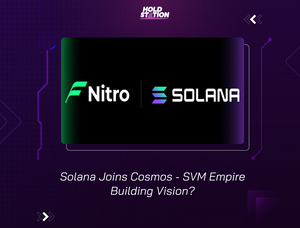If many prominent ecosystems today such as Binance Smart Chain, Fantom, Avalanche, Polygon ... have chosen to join the EVM (Ethereum Virtual Machine) empire, Solana is one of the few to separate itself from the EVM system to build its own "kingdom".
However, this also somewhat limits Solana's interoperability with many other blockchains. Therefore, Sei Labs, a layer1 built to optimize the DeFi world, is working on a plan to increase Solana's potential by solving the above problem, allowing Solana to take advantage of the IBC (Inter-Blockchain Communication) from Cosmos as well as opening the door towards Web3 development.
Nitro - Scaling solution
On 15/9, Sei Labs announced that it is prepping Nitro, a Solana Virtual Machine (SVM)-compatible blockchain, as a gateway between Solana and Cosmos.
Introducing Nitro 🚦The first Solana scaling solution
— Nitro 🚦 (@Nitro_Labs) September 15, 2022
Nitro is building an L2 for Solana that combines Solana’s powerful execution environment and developer community with the thriving Cosmos and IBC ecosystem
A 🧵 on why Solana DeFi users and developers should be excited 👇 pic.twitter.com/nFhGbGfHN4
Nitro will allow developers to easily launch Solana smart contracts right on Cosmos and instantly access the IBC ecosystem - a trade route connecting multiple blockchains within Cosmos. Users can access these applications through the Phantom wallet or many other Solana wallets. This will be the first step towards making SVM a core development standard, in the same way that EVM is enduring today.
Jei-Feng, co-founder of Sei, shared:
“Builders should not be limited by the coding languages they know and instead focus on the best infrastructure for their application. Do people know what language Amazon.com is written in? The reality is that coding languages are abstracted away in Web2, and the same will happen in Web3.”
Nitro’s mainnet expects to launch in early 2023. A testnet should be ready for Solana apps to deploy ahead of that, executives said.
Sei also closed a $5 million venture round last month led by Multicoin Capital. Coinbase’s venture arm, Delphi Digital, Hudson River Trading, GSR, Hypersphere, Flow Traders and Kronos Research participated. This will be part of the fund to help the team survive during this period.
What does this mean?
Most blockchains today are being built using Soliditycode language - one of the most popular code languages in the blockchain world and compatible with the top 1 Ethereum ecosystem, but Solana is different from other blockchains when applying Rust/C/C++. Different smart contract programming languages lead to the problem that dAPPs running on EVM cannot be launched on the non-EVM blockchain.
Therefore, if a project from Solana wants to develop on other blockchains, it has to be reprogrammed from scratch in a language compatible with each blockchain, causing inconvenience to programmers as well as users. From there, it is difficult to expand the ecosystem to attract new cash flows.
Currently, according to data from DeFillama, the total value locked in the Solana ecosystem is estimated at $1.3 billion. If expanded to Cosmos, Solana will be able to further exploit the ecosystem with a total value locked of about $761 million and benefit from Cosmos's active expansion with many potential plans such as the development of Interchain Security.

In addition, the dApp built on Nitro takes advantage of Solana's technology with fast transaction speed, low cost, as well as interactivity thanks to IBC.
For users, everyone can experience both spawning systems at the same time with ease, attributes, and seamlessness.
This marks the stepping stone for SVM work to compete with the EVM system as well as other blockchains.
Summary
Thus, compared to the total value locked of the EVM system, excluding Ethereum, which is currently $13.4 billion, if properly implemented, SVM will be a potential system worth watching.


